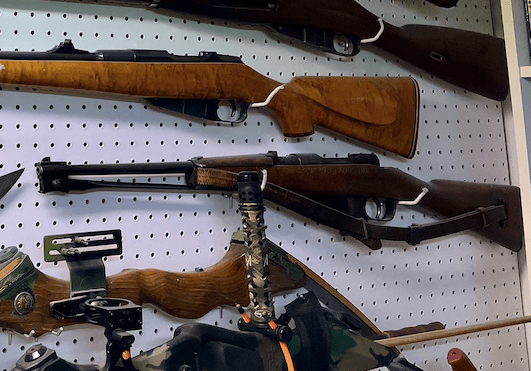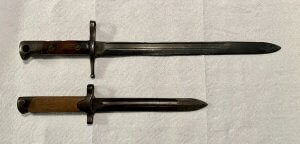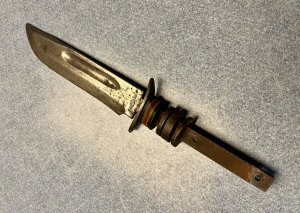Carcano Bayonets

Bottom-most rifle is a Carcano carbine with a permanently mounted, under-folding spike bayonet.
Both of the Italian bayonets in the photo are fullered, meaning their blades have a groove, called a fuller, running down most of their length.

The longer one is an M1891 made at Terni, which is stamped on the right side of the crossguard. The serial number is stamped on the opposite (left) side of the crossguard. Note also the finial (little ball) on the lower end of the unusually long crossguard. The longer lower portion of a bayonet’s crossguard is sometimes called a quillion, especially when curved.
The main purpose of a crossguard is to keep one’s fingers from sliding forward onto the blade when the blade comes to a sudden halt (say, by getting stuck in the other guy’s ribs). The purpose of a longer quillion on a bayonet or sword is to keep the other guy’s blade from sliding down yours and cutting your fingers.
The press stud and spring catch (the little button you push with your left pinkie to release the bayonet, and slide its mortise, or mounting slot, off of the rifle’s bayonet lug) are missing from the longer specimen.
Although longer than the knife bayonet below it, at just over 16 inches of overall length, this one is still not long enough to be considered a “sword” bayonet.
The shorter (about 11 1/3″ overall, with a blade about 7″) Italian bayonet is a Type IIM for the M1938 carbines. This one was made by Rocca, which is stamped on the top, or spine, of the tang (the extension of the blade into the hilt). The SN is also on the spine of the tang.

The Types II and III were simplified, fixed blade versions of the more complicated, and more fragile, folding bayonets originally made for the M1938 series. Unlike most folding bayonets, which are at least semi-permanently attached to the rifle; the Carcano M1938 folders were designed to be easily detachable.
The Type IIs, like this one, retained the folder’s bell-curve shaped metal in the hilt behind the crossguard; on the Type IIIs the wooden grip panels of the hilt go all the way to the cross guard (as on the longer M1891 bayonet in the photo above).
The muzzle rings of both bayonets are just barely too narrow to fit around the barrel of my 7.35x51mm M1938. I’m guessing they may fit around the barrels of 6.5x52mm Carcanos, but many of the 7.35 barrels were simply bored-out older 6.5mm barrels (apparently mine was not).
M1938 Carcanos were produced and issued in both calibers at the same time, much to the chagrin of Italian Army quartermasters. The 7.35 was a newer, harder hitting cartridge than the 6.5, but the logistical burdens of providing both types of arms and ammo during wartime became too great, and by 1940, the Italians had stopped producing the 7.35 rifles. They gave many of the 7.35 M1938s to the Finns, for killing Russians.
For more information, see Giovanni Chegia & Alberto Simonelli’s The Model 1891 Carcano Rifle: A Detailed Development and Production History. It costs more than the rifles used to, but it is THE definitive work on Carcanos, very comprehensive, and well illustrated with photos and diagrams.
